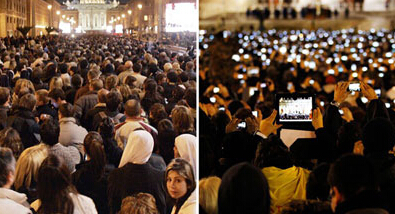In the spring of 2013, two digital photos became an Internet sensation. The first, taken in 2005, depicts a crowd gathered at the Vatican for Pope John Paul II’s funeral. It is shot from behind—backs of heads turned up, and in the bottom right corner, a lone flip phone pointing toward a balcony. The second, taken from an analogous spot in 2013, depicts another throng welcoming the new leader of the Catholic Church, Pope Francis. The photos are nearly identical except for one defining feature. In the 2013 shot, a sea of screens—iPhones, iPads, Androids—rise up above the heads of onlookers, offering a powerful permanent form of witness.
2013年春年,有两张数码照片在网络上引起了轰动。第一张摄于2005年,画面中是人头攒动的梵蒂冈教廷广场,人们在教皇若望·保禄二世的葬礼上举行悼念活动。这张照片是从后面拍摄的,满眼望去,都是翘首向前看的背影,只有照片的右下角,有一支孤零零的翻盖手机对准一座阳台进行拍照。第二张照片几乎是在同一个地方拍摄的,画面中是正在欢迎新加冕的方济各教皇的人群。这两张照片几乎一模一样,区别只有一点。在2013年的这张照片中,大大小小的屏幕汇成了光晕的海洋,人们高高举起自己的iPhone、iPad和安卓手机,见证这历史性的一刻。

Something profound has happened in the time between that first photograph and the second: cheap, dead-simple cameras have crept into everything. By one analyst’s estimate, a billion cameras were added to smartphones and tablets manufactured in 2012. All these cameras have made billions of people into photographers, able to capture and share images of anything with a basic technical proficiency. No one needs to know how a camera works. No one needs to know what an f-stop is, or how to manipulate darkroom chemicals. No one has to be a good photographer to take good photos. One only has to point, shoot, and share.
拍摄第一张照片和第二张照片之间的短短几年,发生了一些影响深远的事情:物美价廉、操作简便的照相机已经进入了千家万户。根据一位分析师的估算,在2012年生产的智能手机和平板电脑中,大约有10亿部都带有照相功能。这些摄像头让几十亿人都成了摄影师,只要学会最基本的操作,就能捕捉和分享任何影像。人们不需要懂得照相机的工作原理,不需要知道什么是光圈,也不用学习怎样在暗房里冲洗胶卷。摄影不再是专业摄影师的专利,大家需要做的只是点开相机,然后拍照、分享。
According to Mary Meeker’s annual Internet Trends report, released May 28, we currently upload and share 1.8 billion photos every single day. This sheer abundance has redefined the nature of the photograph entirely. Pictures are no longer precious; there are just too many of them. Once collected and preserved as art, or to document memories, they are now emerging as a new language, one that promises to be both more universally understood and accessible to anyone. Witness the rise of a new visual vocabulary. Photos, along with emojis, video snippets, GIFS, and other imagery, are replacing written language for many of the things we once relied on words to express.
根据华尔街证券分析师和投行家玛丽o米克尔今年5月28日发布的《年度互联网趋势报告》,如今我们每天都会在互联网上上传、分享18亿张照片。这样海量的照片已经彻底重新定义了“摄影”的含义。图片再也不是什么稀罕东西,因为它们实在是太多了。照片曾经一度被视为艺术被人珍藏,或者被当作记忆的定格被人储存,但现在它已经成了一种新的语言,一种人人都懂、人人都会用的画面语言。近年来,我们已经看到了一种新的视觉词汇的兴起。除了照片,还有表情符号、视频片段、GIF动画和其它图片形式,它们已经可以取代很多过去我们需要依赖文字来表述的东西。
We’ve seen this mass shift in literacy before. Until fairly recently in history, literacy was restricted to the professionals—a small group of educated scribes and religious figures understood to be fit to translate Biblical texts and render contracts. In the 1400s, Europeans were considered literate if they could spell their names—and 80% could not. Then came the printing press. Within a century, people could read and write in growing numbers, and the literate were able to express complex ideas in writing. This mass shift in literacy ushered in progress in science, general education, and the arts. We are now entering a similar period for images. Our smartphones and the Internet that enables them are the modern-day equivalent to movable type, and these tools are still very new.
这种大规模的转变以前在历史上也出现过。一直到离我们不算很远的历史时期,读书写字都是专业人士的工作,只有一小部分受过教育的抄经人和宗教人士的文化程度达到了能够翻译宗教典籍和制订契约的程度。15世纪,欧洲人如果能拼写出自己的名字,就算是识字了,但是有80%的人都拼写不出自己的名字。然而随着印刷机的出现,不到一个世纪,人们的阅读量越来越大,识字的人已经可以用笔墨表达复杂的含义。识字者的大规模增加直接促进了科学、教育和艺术的进步。现在我们在图片上也进入了一个类似的时期,智能手机和互联网所起的作用正如当年的活字印刷术,而些这些工具现在仍然处于发展的早期。
Like many mainstream Americans, I uploaded my first digital photograph to a web site called Shutterfly in 1999. An early adopter, I registered for a Facebook account in 2005, though it took three years for my friends and family to join the service with enough mass to make it a reliable platform for communication. And I got an iPhone in the fall of 2007, shortly after Steve Jobs introduced a device so radical it transformed the phone into a camera.
像许多主流的美国人一样,我在1999年把我拍摄的第一张数码照片上传到了一个叫Shutterfly的网站上。2005年,我又是较早一批注册Facebook的人,不过直到三年后,我的家人朋友才纷纷开始使用这项服务,让它成了我的一个可靠的交流平台。2007年,乔布斯推出了把能手机变成相机的划时代产品iPhone,我也在2007年秋天买了一部。
Now it’s 2014, and I have taken 500 photos in the past month. They include a daily snapshot of my dog on our morning walk, holiday photos of family members cooking together, photos of my notes from interviews, of business cards, the tag to a dress I might buy, the milk I need to pick up from the store. And a hastily snapped “selfie,” or self-portrait, of myself frowning in the dentist’s office, sent to my partner to make the point that I hate visiting the dentist.
现在到了2014年,我光是上个月就拍了500多张照片,包括每天早上遛狗的照片、假期与家人一起做饭的照片、采访时的照片、拍到手机里的名片、我想买的一条裙子的标签、我想去超市里买的一种牛奶,等等。另外还有一张自拍,是我在牙科诊所里皱着眉头的表情,我把它发给了我的搭档,表明我多讨厌去看牙。
For the most part, these photos are not designed to document an occasion. They have become a visual shorthand that is at once more emotionally resonant and more efficient than the words I might once have used to express the same ideas. This shift in the nature of communications will have a substantial effect on culture, business and politics. It’s already reshaping entire industries from advertising to journalism to fashion. It’s powering political campaigns, and will help decide elections. It’s changing the American approach to foreign diplomacy. It’s redefining art and our relationship with the cultural institutions that embody it.
很大程度上,这些照片并不是为了记录某个场景,而是已经变成了一种“视觉速记”,用来表达过去我可能需要文字表达才更有效、更有共鸣的情绪。这种交流方式的变化将对文化、商业和政治都产生重大影响。它已经从根本上改变了从广告到媒体和时尚等很多行业的风貌。它甚至能影响政治宣传,有可能影响选举的结果。它也正在改变美国的外交模式。它还重新定义了艺术,并且影响了我们与文化艺术机构的关系。
Those who embrace this shift early have the opportunity to amass influence in their fields and gain power among their peers. How, you ask? Read on. In this month’s series, Picture This, I plan to chronicle the stories of the people and businesses enabling and evolving new forms of visual literacy. I will write about the toolmakers—the entrepreneurs attending the LDV Vision Summit June 4 in New York, where they’ll discuss computer vision and trends in communications technology. I will introduce you to the communicators—the artists like Mississippi-based Melissa Vincent who are building hundreds of thousands of followers on Instagram, and discovering new ways of telling stories in the process. And I will shed light on the decoders like Brian Kennedy, the curator at the Toledo Art Museum, who has developed a curriculum for visual literacy.
那些最早拥抱这种转变的人将有机会在他们各自的领域里造成重大的影响,同时在竞争中获得优势。如果想知道为什么,请继续阅读本系列文章。在本月的系列专题《拍照吧》(Picture This)中,我将为大家介绍一些创造和发展了新的“视觉语言”形式的人和企业。首先我会介绍一些制造工具的人——比如参加了今年6月4日在纽约举办的LDV视觉峰会的人,他们在会上探讨了计算机礼堂与沟通技术的发展趋势;然后我会介绍一些用视觉沟通的人——比如来自密西西比的梅丽莎o文森特,她在Instagram上已经有了几十万名粉丝,她还在这个过程中发现了一些讲故事的新方法。另外我还将介绍一些解开视觉语言密码的人,比如托莱多美术馆馆长布莱恩o肯尼迪,他专门开设了一门视觉语言课程。
The future belongs to the visually literate. May you be among them.
未来掌握在懂得视觉语言的人手中,希望你也是其中一个。













